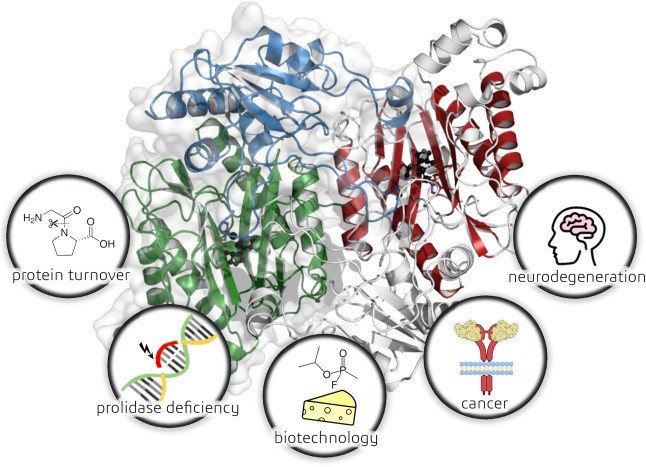What is PEPD protein
Prolidase, also known as PEPD protein, is a cytosolic exopeptidase that holds the responsibility of cleaving dipeptides, two amino acids joined together, containing proline or hydroxyproline at their carboxyl terminal. Essentially, this protein plays a critical role in the cycle of collagen turnover and collagen biosynthesis in the body. The human PEPD protein, encoded by the PEPD gene, is an essential participant in regulating critical physiological functions. Its impact extends from being an essential part of the collagen metabolism pathway to serving therapeutic implications in biomedical applications.
The Role of PEPD Protein
The functionality of PEPD protein rests mainly on the final step in the recycling of proline from degraded collagen. Proline, an amino acid, is a principal component of collagen, a crucial protein that provides strength and structure to various body parts encompassing skin, tendons, ligaments, and bones. The degradation of dietary and endogenous proteins (collagens) generally results in proline-containing dipeptides. The primary task of PEPD protein here is to cleave these dipeptides for releasing free proline, hence ensuring enough amount of proline supply for new collagen synthesis and other proline-requisite metabolic processes. Moreover, PEPD protein also operates as a regulator of cell growth, cell differentiation, wound healing, and immune response.

Fig1. PEPD Protein Function (Piotr Wilk, et al. 2021)
PEPD Protein and Associated Signal Pathway
PEPD protein contributes to multiple cellular signal pathways. The most integral among these are the NF-kB pathway and the mTOR signaling pathway. Through these, PEPD protein modulates inflammatory responses, immune responses, cell survival, proliferation, and apoptosis. The regulation of mTOR signaling pathway by PEPD protein contributes to significant biological processes like protein synthesis, lipid synthesis, autophagy, and lysosomal biogenesis.
PEPD Protein Related Diseases
Alteration or dysfunction in PEPD protein often results in a range of medical conditions. The most notable among these is Prolidase Deficiency (PD), a rare autosomal recessive disorder resulting from mutations in the PEPD gene. This metabolic disease is characterized by a slew of clinical manifestations including infectious ulcers, intellectual disabilities, facial dysmorphism, and generalized developmental delay.
Moreover, aberrant PEPD protein is linked with several other conditions. For instance, high PEPD activity often associates with high cellular proliferation rates witnessed in various human cancers, such as melanoma, breast, lung, and colon cancers. On the other hand, low PEPD activity correlates with chronic diseases like rheumatoid arthritis, liver cirrhosis, or lung emphysema where a slower rate of collagen turnover is observed.
PEPD Protein's Applications in Biomedical
Considering the indispensable role of PEPD protein in cellular functions and collagen metabolism, it increasingly finds application in biomedical research and therapeutics development. Certain experimental studies point towards the prospective use of PEPD as a diagnostic and prognostic biomarker in various cancers, given its high activity in tumor cells.
Moreover, the modulation of PEPD activity is eyed as a potential therapeutic strategy. For instance, the inhibition of PEPD protein could constitute a new way to treat cancers by influencing cell survival and proliferation. Conversely, the enhancement of PEPD activity may prove beneficial in conditions like rheumatoid arthritis or liver cirrhosis, potentially accelerating the collagen degradation.
In conclusion, albeit being an underappreciated and relatively less-explored protein, PEPD serves as a fundamental player in collagen metabolism and other vital cellular pathways. Its relevance in diverse diseases from rare genetic disorders to common cancers underlines its significance. Moreover, PEPD protein holds enormous potential for future biomedical applications, providing innovative ways to approach disease diagnosis and therapeutics. Therefore, understanding the intricate workings of PEPD protein could lead us on the path of unlocking fresh therapeutic potential and novel clinical approaches.
Our Featured Products
| Cat.No. | Product Name | Species | Source (Host) | Tag |
|---|---|---|---|---|
| PEPD-1644H | Recombinant Human PEPD, GST-tagged | Human | E.coli | GST |
| PEPD-3316H | Recombinant Human PEPD protein, His-tagged | Human | E.coli | His |
| PEPD-22H | Recombinant Human PEPD Protein, His-tagged | Human | E. coli | His |
| PEPD-4036R | Recombinant Rat PEPD Protein, His (Fc)-Avi-tagged | Rat | HEK293 | His (Fc)-Avi |
Reference
- Piotr Wilk, Elżbieta Wątor, Manfred S. Weiss. Prolidase – A protein with many faces. Biochimie, Volume 183, April 2021, Pages 3-12.

